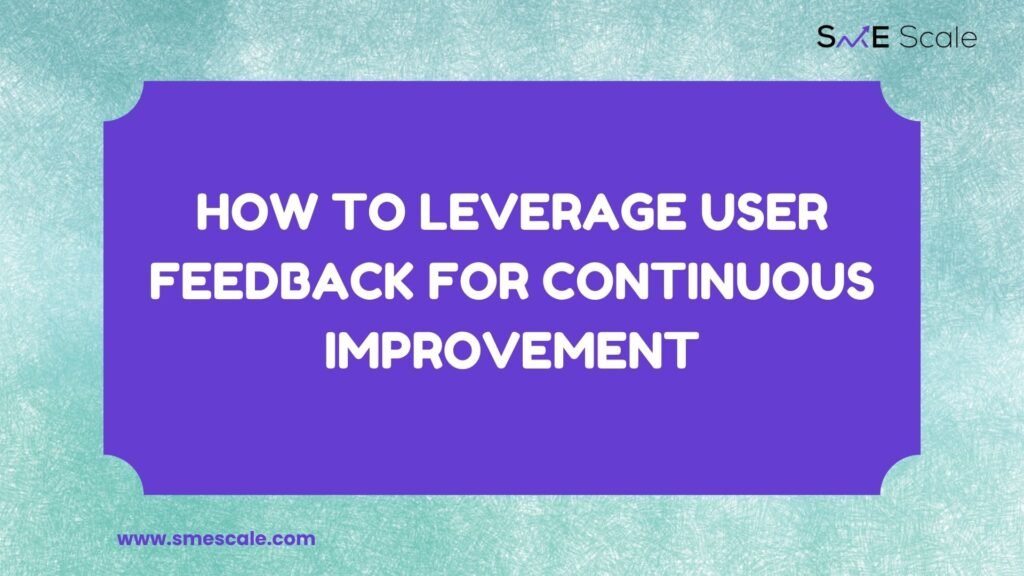How to Leverage User Feedback for Continuous Improvement: A Guide for SMEs

In today’s competitive market, small and medium-sized enterprises (SMEs) must constantly evolve to meet customer expectations and maintain a competitive edge. One of the most effective ways to ensure continuous improvement is by leveraging user feedback. Feedback from customers offers invaluable insights into areas of strength and weakness, helping businesses refine their processes, products, and marketing strategies. In this blog, we’ll explore how SMEs can use user feedback for ongoing improvement, supported by real-life case studies and grounded in psychological principles that drive customer behavior.
Why User Feedback Matters for Continuous Improvement
User feedback is more than just customer reviews or complaints; it’s a goldmine of information that can guide business decisions, foster customer loyalty, and help businesses stay agile in an ever-changing landscape. Feedback loops create a two-way communication channel where businesses learn what customers truly value and how they can better meet those needs. This approach is critical for sustained growth, especially as businesses scale.
Key Benefits of Leveraging User Feedback:
Improved Customer Satisfaction: Regularly seeking and acting on feedback shows customers that their opinions matter, leading to increased loyalty.
Better Products and Services: By understanding customer pain points, businesses can improve their offerings, resulting in higher quality and functionality.
Data-Driven Decisions: Feedback provides a factual basis for decision-making, reducing guesswork and improving overall efficiency.
Case Study: Warby Parker – Scaling Through Customer-Centric Feedback
A well-known example of a company successfully leveraging user feedback is Warby Parker, the direct-to-consumer eyewear brand. Since its inception, Warby Parker has used customer insights to continuously refine its business model and customer experience. One of the standout feedback-driven innovations was their Home Try-On Program, which allowed customers to select five pairs of glasses to try at home before making a purchase.
The program was developed in response to feedback about the uncertainty of purchasing eyewear online without trying it on first. Warby Parker understood that loss aversion, a psychological principle where people are more motivated to avoid losses than to seek gains, played a significant role in their customers’ hesitation. By removing this obstacle and allowing customers to physically experience the product, the company dramatically increased conversions and satisfaction rates.
This initiative also showcased social proof, as the positive experiences shared by early users encouraged others to try the service. The feedback loop allowed Warby Parker to refine the program further, ensuring it catered to customer needs, thus solidifying their position as a market leader.
Psychology of User Feedback: Why It Works
Understanding the psychological drivers behind customer behavior can enhance the way businesses collect and act on feedback. Here are a few psychological principles that play a role in the effectiveness of user feedback:
Reciprocity: When businesses seek feedback, customers often feel a sense of obligation to provide it, especially if they feel their voice will lead to positive changes. This concept can strengthen the relationship between the business and its customers.
Anchoring: Customer feedback, especially early in the buying process, can create a psychological “anchor” that influences future interactions. If the feedback leads to visible improvements, customers are more likely to remain loyal to the brand.
Confirmation Bias: Customers are more likely to stay loyal to a brand that listens to their feedback, as it confirms their initial belief that the business values their input. This, in turn, fosters long-term loyalty.
Practical Steps to Leverage User Feedback for Continuous Improvement
To successfully leverage user feedback, SMEs should follow a structured approach that integrates customer insights into all aspects of the business.
1. Establish Feedback Channels
Creating multiple touchpoints for gathering feedback is essential. Consider using:
Surveys: Send follow-up surveys after purchases to gauge customer satisfaction.
Online Reviews: Actively monitor and respond to online reviews.
Social Media: Use platforms like Instagram and Facebook to engage with customers and gather informal feedback.
In-App Feedback: For businesses with apps, integrating a feedback feature allows users to provide real-time insights into their experience.
2. Use Data Analytics for Deeper Insights
While qualitative feedback is important, pairing it with data analytics provides a clearer picture. Use CRM systems like HubSpot or Salesforce to track customer interactions and identify trends in feedback. Tools like Google Analytics can help understand customer behavior on your website, while Net Promoter Score (NPS) surveys can measure overall satisfaction.
3. Prioritize Feedback and Implement Changes
Not all feedback is equal. Prioritize actionable insights by focusing on issues that impact the most significant aspects of your customer journey. Once changes are made, ensure customers are aware that their feedback was taken seriously—this reinforces the value of their input and increases customer loyalty.
4. Close the Feedback Loop
Closing the feedback loop is critical for maintaining customer trust. Follow up with customers after implementing changes to let them know how their input shaped the outcome. This step not only boosts customer satisfaction but also encourages future feedback.
5. Monitor Progress and Adjust
Continuous improvement is an ongoing process. Regularly track the performance of implemented changes using KPIs such as Customer Lifetime Value (CLTV), Customer Satisfaction Scores, and Churn Rates to ensure the feedback-driven improvements have the desired impact.
Conclusion: The Path to Sustainable Growth
Leveraging user feedback is one of the most effective ways SMEs can drive continuous improvement and sustainable growth. The process is about more than just gathering opinions—it’s about understanding customer psychology, making data-driven decisions, and continuously refining the customer experience. Warby Parker’s success story shows how powerful a feedback-driven approach can be, leading to increased customer loyalty, higher conversion rates, and sustained business growth.
At SME Scale, we believe that continuous improvement is key to long-term success. By prioritizing user feedback and integrating it into your business strategy, you can ensure your SME remains agile, customer-centric, and ready to scale effectively. Whether you’re refining products, optimizing customer service, or developing new marketing strategies, user feedback provides the insights needed to stay ahead in a competitive market.

